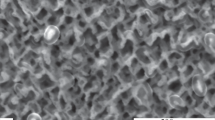Abstract
The type of induced material damage in the tungsten irradiated by using deuterium ions was investigated for various value of the fluence at low energy. Experiments were carried out in an electron cyclotron resonance (ECR) plasma source that provided an ion flux of 2.8 × 1021 D +2 /m2s and a sheath energy of 100 eV/D +2 on the tungsten target. The energy of irradiated ions was much smaller than the threshold energy for generating cascade collisional damage (∼ 250 eV) in tungsten and was similar of the plasma at the first wall of KSTAR. The target temperature was kept as 700 − 800 K by using an active cooling system. Secondary ion mass spectroscopy (SIMS) was employed to observe the depth profiles of deuterium. The peak of the trapped deuterium concentration in the irradiated tungsten was located near 16 − 17 nm for 2.0 − 4.0 × 1025 D 2/m2, which is far deeper than the 1.6 nm for ion implantation at 100 eV/D +2 ions. Thermal desorption spectroscopy (TDS) data were analyzed to determine the binding energy (E b = 1.45 eV) of trapped deuterium, which corresponded to an oversaturation-induced vacancy. This observation is very important for understanding the refueling property of the retained deuterium during steady-state fusion plasma operation.
Similar content being viewed by others
References
R. A. Causey and T. J. Venhaus, Phys. Scr. T94, 9 (2001).
J. Roth and K. Schmid, Phys. Scr. T145, 014031 (2011).
Z. Tian, J. W. Davis and A. A. Haasz, J. Nucl. Mater. 399, 101 (2010).
Y. Hatano et al., Mater. Trans. 54, 437 (2013).
T. Tanabe, Phys. Scr. T159, 014044 (2014).
Y. Liu, T. Ahlgren, L. Bukonte, K. Nordlund, X. Shu, Y. Yu, X. Li and G. Lu, AIP Adv. 3, 122111 (2013).
S. Qin, S. **, L. Sun, H. Zhou, Y. Zhang and G. Lu, J. Nucl. Mater. 465, 135 (2015).
S. Lim, H. Kim, Y. **, J. Lee, J. Song and G. Kim, J. Nucl. Mater. 463, 753 (2015).
F. F. Chen, J. Nucl. Eng. Part C 7, 41 (1965).
J. Bak, H. Kim, J. Kim, K. You and S. Hong, J. Korean Phys. Soc. 65, 1232 (2014).
J. Bak, H. Kim, J. Kim, K. You and S. Hong, Contrib. Plasma Phys. 53, 69 (2013).
J. F. Ziegler, M. D. Ziegler and J. P. Biersack, Nucl. Instrum. Meth Phys. Res., Sect. B 268, 1818 (2010).
R. N. Stuart, M. W. Guinan and R. J. Borg, Radiation Effect 30, 129 (1976).
B. Terreault, G. Ross, R. G. St. Jacques and G. Veilleux, J. Appl. Phys. 51, 1491 (1980).
R. A. Causey, R. Doerner, H. Fraserc, R. D. Kolasinski, J. Smugeresky, K. Umstadter and R. Williams, J. Nucl. Mater. 390–391, 717 (2009).
W. M. Shu, G. Luo and T. Yamanishi, J. Nucl. Mater. 367–370, 1463 (2007).
M. Balden, S. Lindig, A. Manhard and J. You, J. Nucl. Mater. 414, 69 (2012).
P. A. Redhead, Vacuum 12, 203 (1962).
R. L. Blaine and H. E. Kissinger, Thermochim. Acta 540, 1 (2012).
A. M. de Jong and J. W. Niemantsverdriet, Surf. Sci. 233, 355 (1990).
O. V. Ogorodnikova, J. Roth and M. Mayer, J. Appl. Phys. 103, 034902 (2008).
Y. Hatano et al., Mater. Trans. 54, 437 (2013).
A. H. M. Krom and A. Bakker, Metall. Mater. Trans. B 31, 1475 (2000).
R. G. Wilson, Int. J. Mass Spectrom. Ion Processes I43, 43 (1995).
L. Sun, S. **, H. Zhou, Y. Zhang, W. Zhang, Y. Ueda, H. Lee and G. Lu, J. Phys.: Condens. Matter 26, 395402 (2014).
Author information
Authors and Affiliations
Corresponding author
Rights and permissions
About this article
Cite this article
**, Y., Song, JM., Roh, KB. et al. Observation of oversaturation-induced defect formation in tungsten irradiated by low energy deuterium ion. Journal of the Korean Physical Society 69, 518–524 (2016). https://doi.org/10.3938/jkps.69.518
Received:
Accepted:
Published:
Issue Date:
DOI: https://doi.org/10.3938/jkps.69.518



